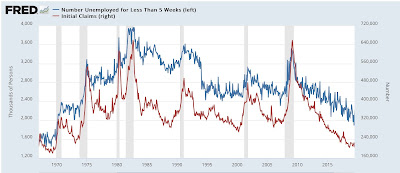– by New Deal democrat Continuing my catching up this week, let’s take a look in some further detail about why I didn’t think Friday’s jobs report portended recession – at least, not yet. As I always point out, the jobs report does contain some leading numbers. These are generally employment in more cyclical industries that, when they turn down, start the cascade into the broader economy. Generally speaking, these are all goods-producing industries, and specifically manufacturing and construction. Usually I also include temporary help, but that has clearly been undergoing some structural changes, so I am temporarily discounting that. Anyway, here is a closer look. First, here are goods producing jobs (gold) vs. manufacturing jobs (blue)
Topics:
NewDealdemocrat considers the following as important: jobs, politics, US EConomics
This could be interesting, too:
Robert Skidelsky writes Lord Skidelsky to ask His Majesty’s Government what is their policy with regard to the Ukraine war following the new policy of the government of the United States of America.
NewDealdemocrat writes JOLTS revisions from Yesterday’s Report
Joel Eissenberg writes No Invading Allies Act
Ken Melvin writes A Developed Taste
– by New Deal democrat
Continuing my catching up this week, let’s take a look in some further detail about why I didn’t think Friday’s jobs report portended recession – at least, not yet.
As I always point out, the jobs report does contain some leading numbers. These are generally employment in more cyclical industries that, when they turn down, start the cascade into the broader economy. Generally speaking, these are all goods-producing industries, and specifically manufacturing and construction. Usually I also include temporary help, but that has clearly been undergoing some structural changes, so I am temporarily discounting that.
Anyway, here is a closer look.
First, here are goods producing jobs (gold) vs. manufacturing jobs (blue) back in the post-WW2 era:
During this time, manufacturing was a much bigger slice of the goods-producing pie, so it is not surprising that the two lines look very similar. Except for the recession caused by the oil embargo (1974) and the Fed-engineered recession of 1981-82, caused by the sudden reversal and sharp increase in rates by Paul Volcker, these always started declining before jobs generally started to decline.
Next, here is the era including when residential construction jobs (red) were specifically broken out:
Note that these have relatively speaking become a larger slice of the pie, as a larger population needs more residences built. They too have always turned down (except for the pandemic) before the overall jobs number have turned.
Finally, here is the post-pandemic close-up:
Manufacturing employment has stalled, but has not in any meaningful sense turned down. Residential construction employment and goods-producing employment generally have continued to rise.
Historically, even more leading than the number of manufacturing jobs (red) has been the average work week in manufacturing (blue). In fact, it is one of the 10 “official” leading indicators in that Index. The below two graphs show the leading relationship on a YoY basis:
Here is the post-pandemic close-up:
There were significant YoY declines in 2022 into early 2023, but the YoY comparison has stabilized this year. This suggests that manufacturing employment is not poised to decline significantly in the months ahead.
Here is the absolute number of weekly hours in manufacturing worked historically:
I include this because the situation changed after 1982, with employees typically working more overtime. It has usually taken not just a decline, but a decline all the way to 40.5 hours before a recession has begun. Except for last winter, we have remained above that line.
For completeness’ sake, here is temporary employment:
This has been almost relentlessly declining for over two years. There is pretty clearly something structural rather than cyclical going on here.
Finally, short term unemployment (blue in the graph below) was historically one of the leading components of the index, before it was replace by initial claims (red):
You can see that they follow similar trajectories, although initial claims are considerably less noisy.
Here is the post-pandemic look:
Both have increased in recent months, with the former starting before the latter. Again, I suspect this has to do with recent immigrants being unable to find jobs, and thus not applying for unemployment.
To conclude, not everything is positive, but the two negative elements both have special considerations. The bulk of the leading data from the Establishment Survey of the jobs report is still forecasting economic expansion in the next few months.
The Bonddad Blog
Economy Still Barely in Expansion. Angry Bear by New Deal democrat










